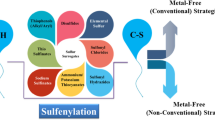Summary
The C-H activation reaction of acetylene by second row transition metal atoms has been studied including electron correlation of all valence electrons. Binding energies have been computed for both π-coordinated complexes and C-H insertion products. It is found that for most atoms the π-coordinated complexes are thermodynamically favoured, just as in the case for the corresponding ethylene reaction. The barrier height for the C-H insertion increases from acetylene to ethylene and to methane. This is in line with the experimental finding that there should be an inverse relation between C-H bond strengths and the difficulty to activate these bonds. To explain the detailed differences between the C-H activation of acetylene and ethylene, the interaction with two, rather than one, π- and π*-orbitals for acetylene is of key importance. The barrier height for the acetylene reaction increases significantly between niobium and molybdenum going to the right in the periodic table, just as for all oxidative addition reactions previously studied. The origin of this increase is that noibium has one empty 4d-orbital but for molybdenum all 4d-orbitals are occupied. Rhodium has the lowest barrier for C-H activation for all systems studied.
Similar content being viewed by others
References
Fischer-Hjalmars I, Henriksson-Enflo A (1982) Adv Quantum Chem 16:1
Fischer-Hjalmars I (1965) in: Sinanoglu O (ed) Modern quantum chemistry, Vol 1. Academic, NY
Blomberg MRA, Siegbahn PEM, Svensson M (1992) J Am Chem Soc 114:6095
Siegbahn PEM, Blomberg MRA, Svensson M (1993) J Am Chem Soc 115:1952
Blomberg MRA, Siegbahn PEM, Svensson M (1992) J Phys Chem 96:9794
Siegbahn PEM, Blomberg MRA, Svensson M (1993) J Phys Chem 97:2564
Blomberg MRA, Siegbahn PEM, Svensson M, J Inorg Chem (in press)
Langhoff SR, Pettersson LGM, Bauschlicher CW (1987) Jr J Chem Phys 86:268
Bauschlicher CW Jr, Langhoff SR (1991) Chem Phys Lett 177:133
Shilov AE (1984) Activation of saturated hydrocarbons by transition metal complexes. Reidel, Dordrecht
Jones WD, Feher FJ (1989) Acc Chem Res 22:91
Huzinaga S (1977) J Chem Phys 66:4245
Almlöf J, Taylor PR (1987) J Chem Phys 86:4070
Raffenetti RC (1973) J Chem Phys 58:4452
Huzinaga S (1971) Approximate atomic functions, II, Dept Chemistry Report, Univ of Alberta, Edmonton, Alberta, Canada
Huzinaga S (1965) J Chem Phys 42:1293
STOCKHOLM is a general purpose quantum chemical set of programs written by Siegbahn PEM, Blomberg MRA, Roos BO, Almlöf J, Pettersson LGM
GAMESS (General Atomic and Molecular Electronic Structure System): Schmidt MW, Baldridge KK, Boatz JA, Jensen JH, Koseki S, Gordon MS, Nguyen KA, Windus TL, Elbert ST (1990) OCPE Bulletin 10:52
Hay PJ, Wadt WR (1985) J Chem Phys 82:299
Chong DP, Langhoff SR (1986) J Chem Phys 84:5606
Martin RL (1983) J Phys Chem 87:750. See also Cowan RD, Griffin DC (1976) J Opt Soc Am 66:1010
Widmark PO, Malmqvist PÅ, Roos BO (1990) Theor Chim Acta 77:291
The coupled cluster calculations are performed using the TITAN set of electronic structure programs, written by Lee TJ, Rendell AP, Rice JE
Sodupe M, Bauschlicher CW Jr (1991) J Phys Chem 95:8640
Sodupe M, Bauschlicher CW Jr, Langhoff SR, Partridge H (1992) J Phys Chem 96:2118
Bryndza HE, Fong LK, Paciello RA, Tam W, Bercaw JE (1987) J Am Chem Soc 109:1444
Stoutland PO, Bergman RG (1988) J Am Chem Soc 110:5732
Author information
Authors and Affiliations
Rights and permissions
About this article
Cite this article
Siegbahn, P.E.M. The activation of the C-H bond in acetylene by second row transition metal atoms. Theoret. Chim. Acta 87, 277–292 (1994). https://doi.org/10.1007/BF01113384
Received:
Accepted:
Issue Date:
DOI: https://doi.org/10.1007/BF01113384




